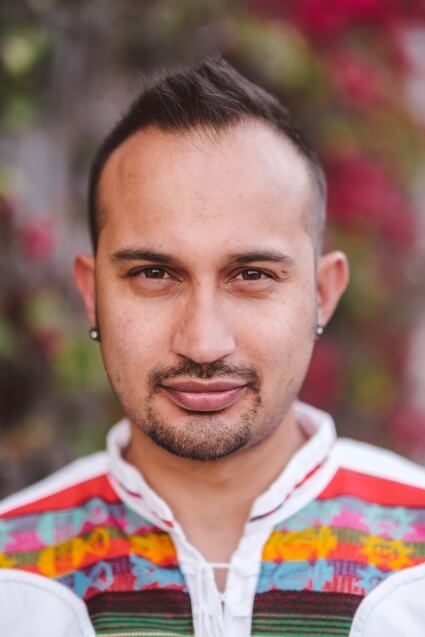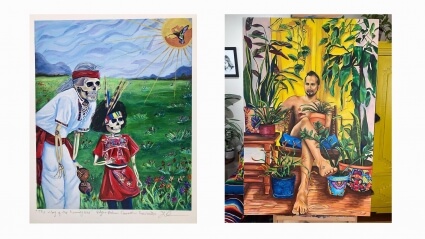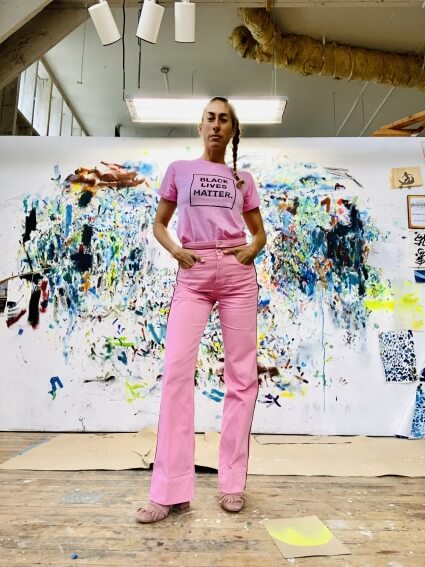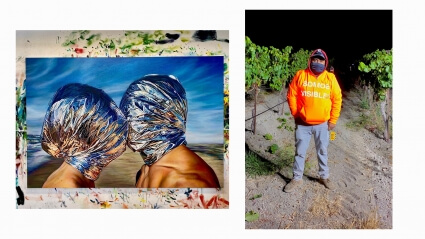Our Artists-in-Residence
The ACLU of Northern California is excited to announce Edgar-Arturo Camacho and Ana Teresa Fernández as the finalists for our inaugural Artist-in-Residence program!
The Artist-in-Residence program seeks to draw on the capacity of art to help people recognize their own power through storytelling, reflecting a vision of them or their history in powerful ways; to motivate people to exercise their power, to humanize issues that are overlooked or ignored, in order to draw the public and decision-makers to an issue in ways that more traditional ACLU methods cannot; and, as we enter a world with many unknowns, to help us imagine a path forward.
The ACLU of Northern California's inaugural Artist-in-Residence program will embed these local artists in an affiliate project for a year-long collaboration to bring art-based and creative strategies to the ACLU's work and to engage impacted communities.
Please get to know Edgar-Arturo and Ana Teresa by viewing the samples of their work below, reading their bio and artist statements, and visiting their websites.

EDGAR-ARTURO CAMACHO
Edgar-Arturo Camacho is a queer Xicanx non-binary artist living on occupied Ohlone land, Vallejo, California. In their proposal, Edgar-Arturo described their current body of work, “which centers on communities of color [and] aims to disrupt the narrative that this country and political system have enacted on people of color. It is the counter-narrative to the anti-immigrant, anti-women, anti-BIPOC, anti-LGBTQ+ sentiment that marginalized communities face daily. In an effort to combat the way that we as POC are portrayed in the media, by law enforcement, and in popular culture, I paint portraits of people from these communities, in power poses that honor their existence and that celebrates, uplifts, and empowers them.” Edgar-Arturo has a background in community organizing in Napa, co-founded the El Comalito Collective for arts education accessible at little to no cost for the community in Vallejo, and combines visual arts (primarily in painting and digital tools) with written poetry to connect with people and help people connect with themselves and community.
Artist Statement: Growing up I often felt alone because of the lack of representation and support for young queer people of color. As a queer Indigenous Xicanx person, I struggled to find others like me who were out, proud and celebrating their culture dressed in vibrant queerness. I used to paint and write poetry as a means to escape the pain, fear, depression, and frustration from the lack of community and family I had but today, I paint my community and culture from a place of joy. The political climate during the Trump administration further marginalized vulnerable communities that this country has historically has taken action against. My current body of work which centers on communities of color aims to disrupt the narrative that this country and political system have enacted on people of color. It is the counter-narrative to the anti-immigrant, anti-women, anti-BIPOC, anti-LGBTQ+ sentiment that marginalized communities face daily. In an effort to combat the way that people of color are portrayed in the media, by law enforcement, and in popular culture, I paint portraits of people from these communities, in power poses that honor their existence and that celebrates, uplifts, and empowers them. I want to show other queer people of color and people in general that they are not alone, so I paint portraits of people who are making a positive difference in our community. I use the juxtaposition of realism and whimsical elements to tell stories that invoke emotions, memories, and dreams. I challenge myself and others to be unafraid of life by allowing themselves to be consumed by the vivid colors in my work which represent growth, love, and life. My work is a symbol of who I am and the unwillingness to compromise the elements which make me, me -- my culture, my queerness, my brownness, my indigeneity, all of me.


ANA TERESA FERNÁNDEZ
Ana Teresa Fernández describes art as her “mother tongue, 6th language and most expansive language that cuts across barriers.” Her body of work focuses on remote or forgotten communities such as, “artists with developmental disabilities, undocumented migrants in the fields of Napa at night, trans-sex workers in Brazil, orphans from victims of femicides in Mexico, and at risk youth in South Africa and Haiti.” Ana works with many different mediums including sculpture, paint, textiles, installations, and community engagement, “attempting to illuminate the beauty to create a sense of awe and visibility [and…] integrating the narrative and voices that have been pushed outside the margins, finding ways to include them in the center.” In one of her more recent projects, she developed sweatshirts for farmworkers to wear that say "Somos Visibles" to encourage participation in the census.

Artist Statement: Through painting, performance, installation and video, I enact and participate in the politics of intersectionality, as it shapes the personal identity, the political rhetoric and culture, and the everyday tasks of ordinary people. My work illuminates the barriers, both psychological and physical, that confine and divide gender, race, and class in western society and the global south.
My performances investigate how women identify their strengths and sensuality with acts of labor in which there is no visible economic or social value; in fact, many of these tasks are frequently considered "dirty." I use painting as a form of documentation of these performances and, in doing so, I challenge the medium's mostly-male and privileged history that elides labor and the messy process of making. I feel my documentation of performance through paining renders it more contemporary because it is a copy of the real in the original sense of simulacrum.
The painting to documentation process begins with site-specific performances that are first photographed. I use the photo to create the paintings in which I depict myself completing a real action, in a real time and space. The sites I choose are already politically or historically charged. I dress in Tango attire, performing cleaning activities, domestic chores, or actions that use my body as a measuring device. I push against the space of the performance, knowing its tangibility will be more material in the film. The dance references the battle between media representations of gender and autonomy, or the agency we seek to perform our own identities. I believe performing this tension confronts issues of labor and power.
Working with these themes has led me to dialogue, collaborate, and create both public and private works within various communities and residencies in the US, Mexico, Haiti, Spain and South Africa. Interactive installations and public interventions are an imperative part of my practice as an artist. I use an array of materials that directly engage the history and tension of a site. The public sphere and the bodies who comprise it are always essential to my work because it becomes the catalyst and activator. In Borrando la Frontera (Erasing the Border) I painted the US/Mexico divisor fence in Tijuana, sky blue to erase a portion of it. I created 5 large scale light public art installations in Downtown San Francisco asking the questions WHO, WHAT, WHEN, WHERE, WHY, to address and create public dialogue about the ongoing social tension about the gentrification in Mid Market area.
My work presents the body in ways that question how we often see things. It offers moments of reflection in the most mundane of places. I am interested in using my visual language to transcend the given and provide alternate truths.
